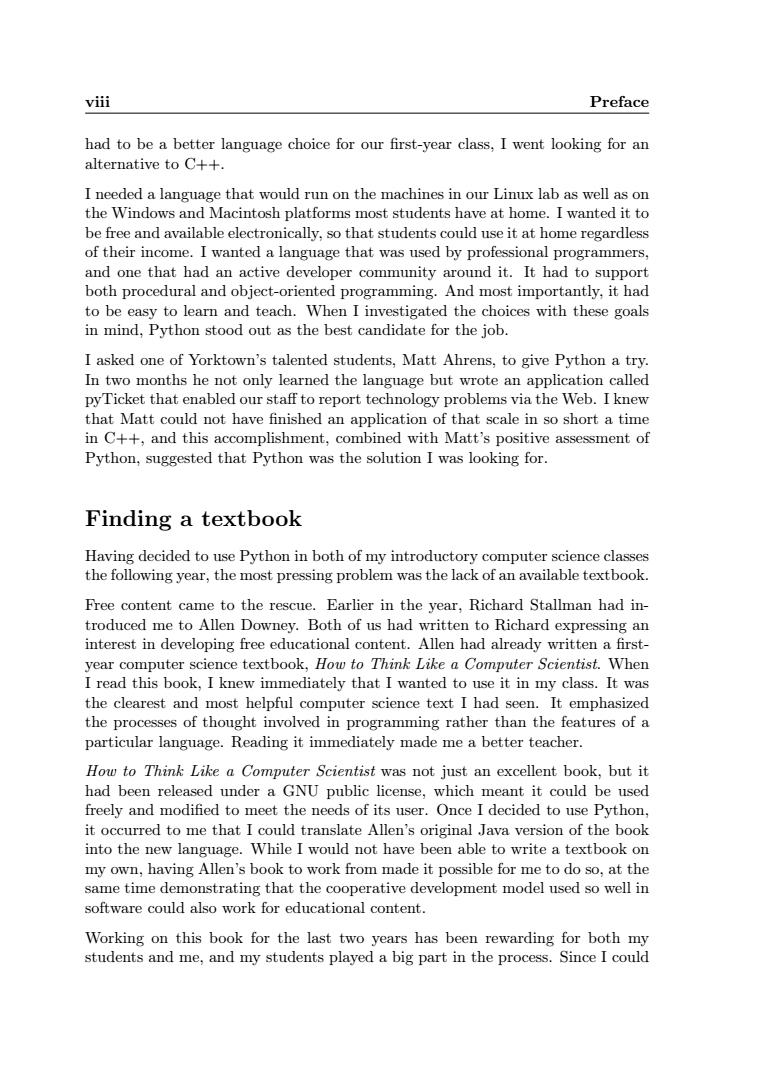正在加载图片...

viii Preface had to be a better language choice for our first-year class,I went looking for an alternative to C++. I needed a language that would run on the machines in our Linux lab as well as on the Windows and Macintosh platforms most students have at home.I wanted it to be free and available electronically,so that students could use it at home regardless of their income.I wanted a language that was used by professional programmers, and one that had an active developer community around it.It had to support both procedural and object-oriented programming.And most importantly,it had to be easy to learn and teach.When I investigated the choices with these goals in mind,Python stood out as the best candidate for the job. I asked one of Yorktown's talented students,Matt Ahrens,to give Python a try. In two months he not only learned the language but wrote an application called pyTicket that enabled our staff to report technology problems via the Web.I knew that Matt could not have finished an application of that scale in so short a time in C++,and this accomplishment,combined with Matt's positive assessment of Python,suggested that Python was the solution I was looking for. Finding a textbook Having decided to use Python in both of my introductory computer science classes the following year,the most pressing problem was the lack of an available textbook Free content came to the rescue.Earlier in the year,Richard Stallman had in- troduced me to Allen Downey.Both of us had written to Richard expressing an interest in developing free educational content.Allen had already written a first- year computer science textbook,How to Think Like a Computer Scientist.When I read this book,I knew immediately that I wanted to use it in my class.It was the clearest and most helpful computer science text I had seen.It emphasized the processes of thought involved in programming rather than the features of a particular language.Reading it immediately made me a better teacher. How to Think Like a Computer Scientist was not just an excellent book,but it had been released under a GNU public license,which meant it could be used freely and modified to meet the needs of its user.Once I decided to use Python, it occurred to me that I could translate Allen's original Java version of the book into the new language.While I would not have been able to write a textbook on my own,having Allen's book to work from made it possible for me to do so,at the same time demonstrating that the cooperative development model used so well in software could also work for educational content. Working on this book for the last two years has been rewarding for both my students and me,and my students played a big part in the process.Since I couldviii Preface had to be a better language choice for our first-year class, I went looking for an alternative to C++. I needed a language that would run on the machines in our Linux lab as well as on the Windows and Macintosh platforms most students have at home. I wanted it to be free and available electronically, so that students could use it at home regardless of their income. I wanted a language that was used by professional programmers, and one that had an active developer community around it. It had to support both procedural and object-oriented programming. And most importantly, it had to be easy to learn and teach. When I investigated the choices with these goals in mind, Python stood out as the best candidate for the job. I asked one of Yorktown’s talented students, Matt Ahrens, to give Python a try. In two months he not only learned the language but wrote an application called pyTicket that enabled our staff to report technology problems via the Web. I knew that Matt could not have finished an application of that scale in so short a time in C++, and this accomplishment, combined with Matt’s positive assessment of Python, suggested that Python was the solution I was looking for. Finding a textbook Having decided to use Python in both of my introductory computer science classes the following year, the most pressing problem was the lack of an available textbook. Free content came to the rescue. Earlier in the year, Richard Stallman had introduced me to Allen Downey. Both of us had written to Richard expressing an interest in developing free educational content. Allen had already written a firstyear computer science textbook, How to Think Like a Computer Scientist. When I read this book, I knew immediately that I wanted to use it in my class. It was the clearest and most helpful computer science text I had seen. It emphasized the processes of thought involved in programming rather than the features of a particular language. Reading it immediately made me a better teacher. How to Think Like a Computer Scientist was not just an excellent book, but it had been released under a GNU public license, which meant it could be used freely and modified to meet the needs of its user. Once I decided to use Python, it occurred to me that I could translate Allen’s original Java version of the book into the new language. While I would not have been able to write a textbook on my own, having Allen’s book to work from made it possible for me to do so, at the same time demonstrating that the cooperative development model used so well in software could also work for educational content. Working on this book for the last two years has been rewarding for both my students and me, and my students played a big part in the process. Since I could